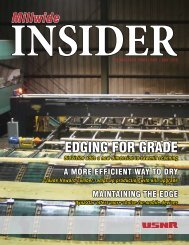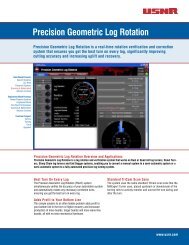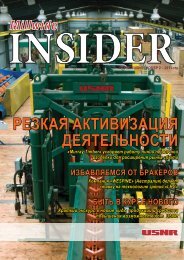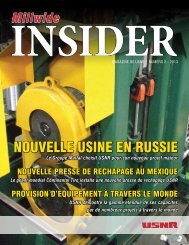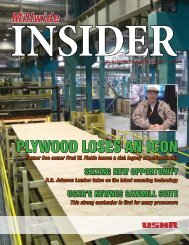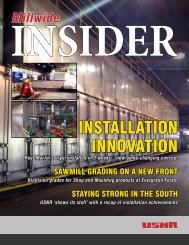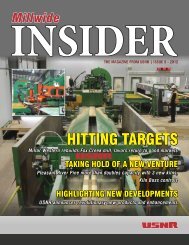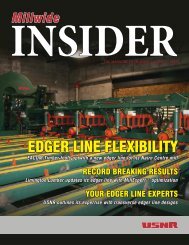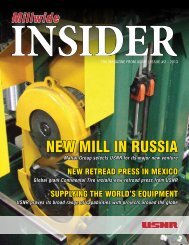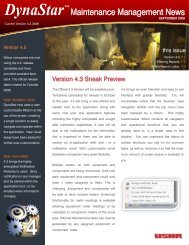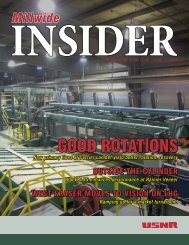You also want an ePaper? Increase the reach of your titles
YUMPU automatically turns print PDFs into web optimized ePapers that Google loves.
Poles exit the dry end of the kiln once the drying cycle is complete.New kilnThe new kiln USNR designed is 35’ wide x 165’long, with double tracks to accommodate a largequantity of poles in one charge. It is constructedwith a steel frame and pre-fabricated aluminumpanels. One unusual aspect of this kiln is theaddition of a temporary wall that can be closedacross the middle of the kiln. This creates twosealed drying chambers, allowing the plant theflexibility of two separate charges at one time.Though this is not common, USNR has provided thisfeature previously at another installation.The new kiln has the capacity to dry 16,000cubic feet (of poles) per charge, and a kiln load ofpoles will dry in 4.5 days – down from 8 days withthe old drying unit. Dan Winkle, plant manager,commented, “We are able to dry 3.5 times theamount in half the time.”The kiln is fueled by a 300hp natural gasboiler producing steam heat. The steam producescondensate that is collected in an in-groundA pole is peeled prior to drying.condensate tank and then pumped back into theboiler in a closed-loop process.PWP dries their poles prior to treating, becausewhen the poles are green the preservative will notproperly penetrate the wood. Drying Douglas firlumber is significantly different from drying poles.Typically Douglas fir stud or dimension lumberdries in the range of 24 to 48 hours at a maximumtemperature of 200F degrees. In the case of poles,only the outer sap of the pole is dried – typically2-3 inches deep, at a maximum temperature of180F degrees. The pole’s sap is treated after thepoles are dried.<strong>Co</strong>ntrolling the processTwo other features of this new kiln are Kiln Bosscontrols and a moisture sensing system from SCSForest Products. The Kiln Boss system provides expertcontrol of all the drying variables. The Kiln Bosssystem is configured to control 8 heat zones with theheat source, venting and fans, and works in tandemwith the SCS in-kiln moisture sensing system. TheSCS system has 8 measuring points; the moisture“We are able to dry 3.5 times the amountin half the time.”readings are fed to the Kiln Boss system to controlthe drying schedule and shut-down the kiln at theend of the cycle. A Kiln Boss system equipped withmoisture sensing input allows the plant to use timeormoisture-based scheduling. The Kiln Boss systemmonitors energy usage to ensure the most efficientoperation and management of the kiln system.The Kiln Boss system also controls the old kilnwith a single heat zone, and includes a steampressure sensing unit for steam management; itcloses selected control valves when the pressurein the steam main falls below a predeterminedlevel. An additional four SCS moisture sensors willmeasure the core temperature of the poles in thisdrying chamber.The Kiln Boss and SCS systems are accessedthrough a single computer displaying the operatorinterface for the system. The SCS moisture sensingsystem helps to improve grade recovery (whendrying lumber) and eliminate over-drying. It is fullyintegrated with the Kiln Boss system to automaticallymeasure and chart the moisture content of the polesas they dry from multiple sensing points in thecharge. Utilizing these measurements, the Kiln Bosssystem targets the optimum point to shut down eachkiln run.The new kiln has the capacity to dry16,000 cubic feet (of poles) per charge.4Millwide INSIDER | ISSUE 6 - <strong>2012</strong>



